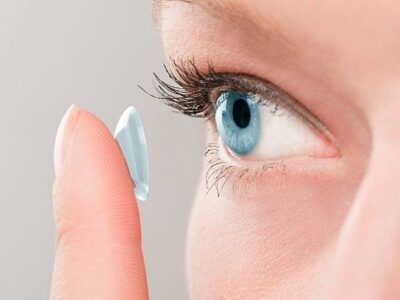Millions of people around the world wear contact lenses — more than 24 million in the United States alone. Depending on your lifestyle, your motivation and the health of your eyes, contact lenses may provide a safe and effective alternative to eyeglasses when used with proper care and maintenance.
What are contact lenses?
Contacts are thin, clear disks of plastic that float on the tear film that coats the cornea, the curved front surface of the eye. The health of the corneal surface and tear film are very important to your comfort and the clarity of your vision when you are wearing contacts.
Contact lenses are used to correct the same conditions that eyeglasses correct:

What are the different types of contact lenses?
Many different plastics are used in the manufacture of contact lenses, but basically there are two general types of lenses: hard and soft.
Hard lenses include the PMMA contacts that were first developed in the 1960s but are rarely used today; and rigid gas-permeable, or RGP, contacts. RGP contacts combine plastics with other materials such as silicone or fluoropolymers to produce a lens that holds its shape, yet allows the free flow of oxygen through the lens to the cornea. These lenses are more “wettable,” easier to adjust to and more comfortable to wear than the old PMMA hard lenses.
RGP lenses may be the best choice when the cornea has enough astigmatism (is shaped like an egg instead of an orange) that a soft lens will not provide sharp vision. They may also be preferable when a person has allergies or tends to form protein deposits on his or her contacts.
Soft lenses are the choice of most contact lens wearers for their comfort as well as for the great number of options available. These options include:
Daily wear. These contact lenses are worn only during the day, and removed when sleeping. The lenses may be on a frequent replacement program with new lenses daily, weekly, or monthly, and may also be called “disposable” contact lenses. There are longer-term replacement programs with replacement recommended every three, four or six months.
Extended wear. These lenses are worn overnight, but are removed at least weekly for thorough cleaning and disinfection. They are being recommended less frequently since there is a greater risk of serious corneal infection with any overnight wear of contact lenses.
Toric contacts. These soft contacts can correct astigmatism, though not as well as RGP lenses. Toric lenses usually cost more than other soft lenses and may be prescribed as daily wear or extended wear.
Colored or tinted contacts. Many daily wear, extended wear, and toric lenses come in a variety of colors and tints. These lenses can change the appearance of your eye color to varying degrees.
Decorative (plano) contact lenses. These are lenses that do not correct vision, but rather change the appearance of the eye. For example, these lenses can change the color of the eye from brown to blue, or can make your eyes look strange by portraying Halloween themes. Although these lenses do not correct vision, they carry the same risks as other contact lenses, and should only be worn by prescription. You must thoroughly clean and care for these lenses just like any other contact lens.
As one ages, correction for near vision is often necessary because the lens of the eye can’t change shape as easily as it once did. This common condition, called presbyopia, can be corrected in one of three ways:
wear your distance correction in the contacts, and wear reading glasses when needed;
wear one contact for distance vision, and one for near vision. This option is called monovision, and it works well for many people but not for everyone. You may need a trial period to decide if monovision is for you;
wear bifocal contacts, which are designed to allow both distance and near vision. These lenses are usually more expensive to fit and some people may have difficulty adjusting to them. However, bifocal contacts may provide good vision for most distance and near tasks without the use of glasses.
Special uses for contact lenses include “bandage” lenses, to cover the corneal surface and provide comfort after injury or surgery; lenses for infants; RGP lenses, for people with very irregular corneas due to injury or disease; and painted contact lenses, to change appearance or reduce glare after eye trauma.
